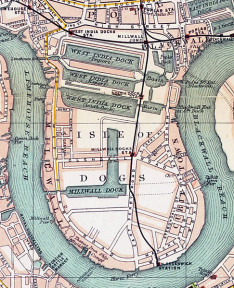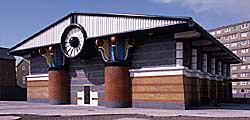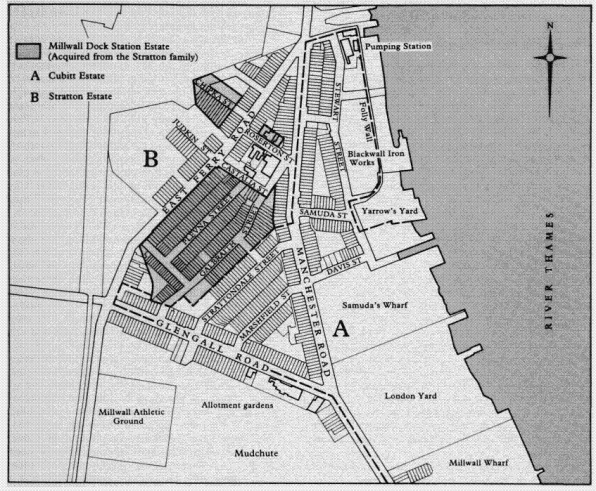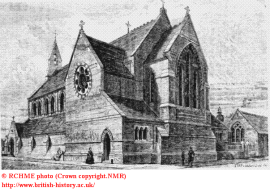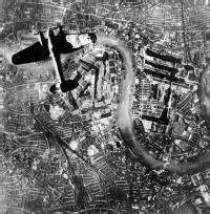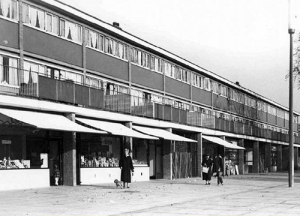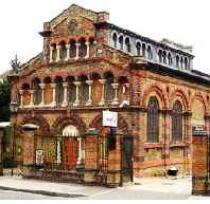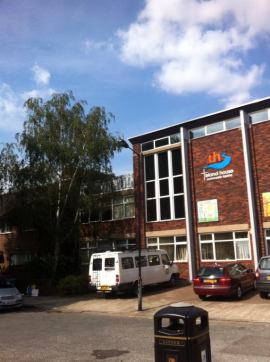Our History
Island House Community Centre opened in January 1972 as the new home of St Paul's Presbyterian Church, which claims the record of being the last Presbyterian church built in the UK, before becoming part of the newly formed United Reformed Church denomination.
It was formed from the former Poplar Presbyterian Settlement and St Paul's Presbyterian Church who amalgamated to establish Island House as a "new showpiece church and social centre". By so doing, they not only brought the name of 'St Paul's' back to Cubitt Town after a century's absence, but also continued the site's long heritage of Christian worship, education and community provision.
The site
Since it was first developed in the 1860's, the immediate surrounding area of Roserton Street and the former Castalia Street have had a long history of providing social and commuity services within the Christian tradition.
It was the home of both St Paul's National School and St John's Church (both now demolished). Island House is located on the north side of Roserton Street, on the site of the former workmen's clubhouse and the old St John's mission hall and boys club, that became the post-war venue for St John's Church itself in the 1950's and 60's.
An area with housing issues:
Thanks to the expansion of the docks, Cubitt Town was undergoing a huge development in the 1860's. It grew rapidly from 200 to over 1,000 homes in less than a decade. However, ever since the area was first developed, the Island House site seems to have been serving a community struggling with the consequences of its poor quality housing, brought on partly by the area's own particular geography.
Cubitt Town had been built on the Isle of Dogs, known formerly as Stepney Marshes and part of the Thames flood plain. One of the problems of the housing in Cubitt Town was that many basements were liable to flooding during periods of heavy rainfall, when the sewers were unable to carry the sudden increase in volume.The difficulty was reported as early as 1866 and, although the completion of the outfall sewer alleviated it for a time, flooding became increasingly frequent during the 1880s, with particularly severe flooding after storms in June 1880 and June and July 1888.The completion of the pumping station at Stewart Street in 1889 did reduce the incidence of flooding, but did not remove the problem.The area was particularly affected during the disastrous flooding on 7 January 1928, when the river overflowed at Johnson's drawdock.
The Medical Officer of Health found it 'scarcely credible that... it is possible to build houses with sunken basements, without the intervention of concrete or other impervious layers on low-lying, damp soil difficult to drain and sewer and liable to floods and overflow of sewage'. Nevertheless, a report of 1890 showed that there were 711 houses with basements in Cubitt Town. Many were found to be in a 'deplorable unsanitary condition' with foul and moist basements, and rising damp, which was partly attributable to the use of poor materials.There were occasional outbreaks of scarlet fever.The houses were, in general, poorly built and badly maintained; by the 1910s many were in bad repair and the streets appeared 'dreary, slummy' presenting 'ugly vistas'.Those in Davis and Samuda Streets were singled out as being in a dilapidated condition by the end of the nineteenth century.The state of the houses in Olliffe Street attracted the attention of the LCC in the 1900s and some were pulled down as a result. Even so, there had been little clearance of condemned buildings in the district by 1939. It took German bombers to fix that as the area was at the centre of the WWII Blitz.
A site for Education and Worship:
The present Island House site was originally part of the St Paul's School and St John's Church complex of buildings, clustered around Roserton and Castalia Streets.
St John' Church, Cubitt Town had it’s origins in St Paul's Mission. The Mission was established in 1866, and held its services in a wooden hut near the Millwall Docks.
In 1868–9, following a remarkable decade of new housing development that had seen the population of Cubitt Town grow five-fold, a much needed new school was built on a 'patch of waste ground to the west of Manchester Road'. The school building was erected facing Roserton Street, with the adjoining site reserved for a new church and vicarage.
St Paul's National School opened in October 1869, and for the next three years the St Paul’s Mission services were able to be held in the new school buildings.
In 1870 Mrs Isabelle Laurie, a 'munificent Churchwoman' from Maxwelton in Scotland, offered the Bishop of London money to build a new church “wherever one was most urgently needed”. The impoverished mission of St Paul's in Cubitt Town was selected and by 1871 work was under way on the new church.
Presumably because the available site (now Island Medical Centre on the south side of Roserton Street) was constricted by the adjoining school, the church was aligned north-south - the only instance of this unorthodoxy among Poplar's Anglican churches.The new building to house St Paul's mission church, which had cost £5,255 to build, was consecrated in December 1872 under the new name of "St John's" in its own parish; little did they know that a century later in 1972, their former name of “St Paul’s” would return to Roserton Street when the Presbyterian church by that name would relocate there as part of Island House.
St John’s vicarage was added in 1876 on the south side along Castalia Street.This capacious two-storey brick house stood alone in large walled gardens with eastern and western entrance gates on both Galbraith Street and East Ferry Road respectively. It stood in stark contrast to the densely packed workmen's housing surrounding the area.
A site for community provisions:
On the north side of Roserton Street (the present site of Island House), the trustees of the Bishop of London's Fund acquired further plots from the British Land Company, and in 1885–6 a spacious mission hall was erected, together with houses for the verger and senior curate. Additions were made to this group in 1892, and in 1897 a large two-storey workmen's Club-house was built adjoining the hall. A second clubhouse, for boys, was erected to the west of the clergy house in 1900. And so, the Island House site began serving the local working community and young people.
St John's appears to have been the most vigorous and active of the three original Anglican parishes on the Isle of Dogs, and throughout its history was noted for its 'high' Anglo-Catholic practices. Attendances at the church exceeded those at Christ Church and St Luke's in the late nineteenth and early twentieth centuries, and by 1939 the annual attendance figures for St John's had reached 6,000, ten times those of Christ Church.
A site Blitzed and redeveloped
Of this large complex of buildings, only the mission hall and club-house in Roserton Street survived the Second World War bombing reasonably intact. The St Paul’s School buildings were badly damaged and had to be demolished soon after. St John’s Church was damaged during air raids in 1941 and was abandoned, eventually to be demolished in the 1950s to make way for the new "Castalia Square". The vicarage in Castalia Street had been destroyed by a direct hit in the war, and in 1955 was replaced by a new clergyhouse on the north side of Roserton Street overlooking the new Square, adjoining the St John's mission hall and club house. This was called St Mildred's House to continue the name of the former Anglican settlement in Millwall; St Mildred's House was used temporarily by Island House as an overflow to provide offices for the Health Trainers project in 2010-11.
A site celebrated:
Poet Laureate John Betjamin visited the Isle of Dogs in 1956 where he made an unexpected discovery. He wrote in the Spectator:
"One of the best new housing estates I have seen since the war, comparable with Lansbury, intimately proportioned, cheerful and airy and yet London-like. It is called Castalia Square and makes one realise, when one compares it with the gloomy blocks of ‘artisans’ dwellings’ of the mid-war and pre-1914 periods, how good modern architecture can be. In all the destruction I record in this column, it is a pleasure to be able to write about something newly built which makes one’s heart rejoice".
A plaque on the edge of the Square shows that in 1992, the Square was re-furbished and re-opened by Radio 1 DJ Bruno Brookes!
The new site of St John's Church 1955-1970
During the war years, between 1939 and 1947, St John's had lost 90 per cent of its communicants, and the three Island parishes were merged in 1952. The old mission hall adjoining the workmen's clubhouse (on the site of what is now Island House) was refitted as the new St John's Church and dedicated in 1955. However, through the post war decades, church attendances continued to fall, and in 1965 the congregations of St John's and Christ Church were combined. Christ Church in Manchester Road was rededicated as the "Church of Christ and St John".
Following fire damage, in 1970 the new St John's Church and clubhouse in Roserton Street were eventually demolished to make way for the development of Island House.
ISLAND HOUSE 1972- present:
The site was acquired by the Presbyterian Church of England to be redeveloped as “Island House”, replacing the St Paul's Presbyterian Church in Westferry Road and the old Poplar Presbyterian Settlement.
The former St Paul's Presbyterian Chapel in Westferry Road had been nicknamed the 'Scotch Chapel' because the congregation was largely made up of Scottish Presbyterian dock workers. After the relocation of St Paul's congregation to the new Island House, the former Presbyterian chapel was eventually redeveloped in the 1990's by social entrepreneur Robert Richardson and transformed into a new performing arts centre, now known as "The Space". (St. Paul's Art Centre)
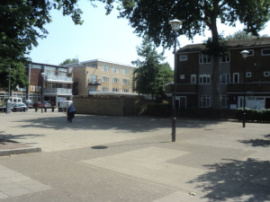 Island House [left of picture], the "showpiece social centre", opened in 1972 facing Castalia Square
Island House [left of picture], the "showpiece social centre", opened in 1972 facing Castalia Square
"A Showpiece Social Centre"
Designed as a 'showpiece' social centre, the new three-storey complex that made up Island House included a church believed to be the last Presbyterian church built in England: this is because, shortly after its completion in 1972, the Presbyterian Church of England amalgamated with the Congregational Church to form the United Reformed Church.
As well as a sanctuary for St Paul's Presbyterian, the new development included a manse and multi-purpose community space, continuing the historical tradition of a church-based community provision on this site and replacing that formerly provided at the Poplar Presbyterian Settlement at the former St Paul's Chapel.
The cost of building Island House was about £45,000, of which nearly a fifth was met by grants from the London Borough of Tower Hamlets and the Government's Urban Programme. The site is now owned by the Thames North Trust of the United Reformed Church and held in trust for Island House Community Centre.
Now a registered charity in its own right, Island House continues to champion education and social welfare for the benefit of the residents of Cubitt Town and provide a site for Christian worship and community service in an area of rapid redevelopment and change. So perhaps some things don't change!
Acknowldegements
From: 'Cubitt Town: The inland area', Survey of London: volumes 43 and 44: Poplar, Blackwall and Isle of Dogs (1994), pp. 498-514. URL: http://www.british-history.ac.uk/report.aspx?compid=46526 Date accessed: 01 December 2014.
RECENT HISTORY
St Paul's Church, now part of the United Reformed Church denomination since 1972, continues to have a presence through it's chapel at the heart of the community centre, providing a focus for prayer and worship. The values of the Christian faith continue to underpin all Island House activities.
In the early 21st century, Island House took on a new challenge. Instead of just having a United Reformed Church Minister at the helm, a new Centre Director, Louise Pears, was appointed to develop the centre's facilities and community projects. To provide more space for this, the manse was amalgated into the main church and community centre in a major refurbishment that also saw the entrance and reception areas made more welcoming.
Working with Committee Convenor Cristine Smalligan appointed by the URC Thames North Synod, four key themed areas were identified in which Island House would start to develop it's own programme of activities . They were:
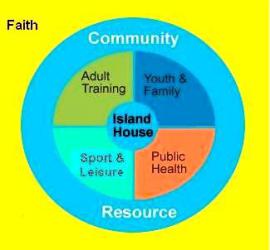 The 4 themed Key Delivery Areas of Island House, a Community Resource Hub founded on the values of the Christian Faith
The 4 themed Key Delivery Areas of Island House, a Community Resource Hub founded on the values of the Christian Faith
- ADULT LEARNING & EDUCATION
- YOUTH & FAMILY SERVICES
- PUBLIC HEALTH PROJECTS
- INTER-FAITH WORK
In 2008, following the appointment of a new Centre Director, Steve Hill, Sport & Leisure was added to the key project delivery areas and the use of the new community space was further developed by bringing in a wide range of regular user groups.
The wide reaching programe of community projects continued to develop and a number of key commissions from the local authority, the local Primary Care Trusts and Tower Hamlets Public Health were added.
Significant Island House projects between 2005 and 2014 have included:
THE 'MUST' Youth project led by Angela Greenaway
THE EXPERT PATIENTS PROJECT led by Jahera Ali
THE HEALTH TRAINERS PROJECT managed by Cece Ekprikpo
THE YOUTH SOCIAL ENTERPRISE PROJECT "CafE14" started by Angela Greenaway
GREENING ISLAND HOUSE overseen by Cristine Smalligan
THE JOSH LEWSEY RUGBY ACADEMY coordinated by Centre Director Steve Hill.
These all made significant and positive contributions to Island House
and the welfare of the local community.
For over 40 years, Island House has also initiated or been home to a wide range of other community organisations and service providers, including:
- Island Advice Centre
- Island House Playgroup
- Docklands Outreach
- Island History Trust
- Isle of Dogs Childrens Centres
- Isle of Dogs Bangladeshi Association
- Quaystone Christian Church
- 2nd East London Scout Group
- In January 2016, the charity's Trusteeship transferred from the URC Thames North Synod Executive to our own local Management Committee to allow more local accountability. The premises continues to be held in trust for the charity by the URC Thames North Trust.

